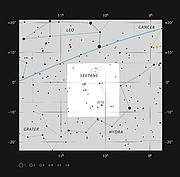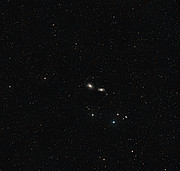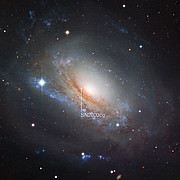Comunicato Stampa
Una coppia galattica disturbata
20 Aprile 2011
Le galassie che formano questa coppia cosmica, riprese dallo strumento WFI (Wide Field Imager) montato sul telescopio dell’MPG/ESO di 2,2 metri all’Osservatorio di La Silla in Cile, mostrano tratti curiosi, dovuti al fatto che i componenti della coppia sono sufficientemente vicini da ristentire dell’influsso gravitazionale del compagno che ne distorce la forma. Questo “tiro alla fune” gravitazionale ha deformato la forma a spirale di una galassia, NGC 3169, e frammentato le bande di polvere nella compagna, NGC 3166. Nel frattempo, una terza galassia, NGC 3165, la più piccola in basso a destra, sta come in prima fila ad assistere al tira e molla gravitazionale dei suoi vicini più massicci.
Questo gruppo di galassie, che si trova a circa 70 milioni di anni luce da noi nella costellazione del Sestante, fu scoperto dall’astronomo inglese William Herschel nel 1783. Gli astronomi moderni hanno stimato la distanza tra NGC 3169 (a sinistra) e NGC 3166 (a destra) in appena 50 000 anni luce, cioè circa la metà del diametro della Via Lattea. In questi spazi ristretti la forza di gravità può causare grandi danni alla struttura delle galassie.
Le galassie a spirale come NGC 3169 e NGC 3166 di solito mostrano vortici ordinati di stelle e polvere che come una girandola ruotano attorno al centro luminoso. Incontri ravvicinati con altri oggetti massicci possono disturbare la configurazione normale. Questa fase in cui le galassie appaiono deturpate spesso prelude all’unione delle due galassie in una più grande. Finora. l’interazione tra NGC 3169 e NGC 3166 ha accentuato appena le loro peculiarità. I bracci di NGC 3169, che risplendono di giovani grandi stelle blu, sono stati distrutti e molto gas luminoso è stato strappato dal disco. Nel caso di NGC 3166, le bande di polvere che di solito delineano i bracci a spirale sono scompigliate. Diversamente dalla sua compagna più blu, NGC 3166 non sta formando molte nuove stelle.
NGC 3169 ha un altro segno distintivo: il punto giallo che brilla tra veli di polvere scura appena alla sinistra del centro della galassia [1]. Questo bagliore è ciò che rimane di una supernova vista nel 2003, nota come SN 2003cg. Si pensa che una supernova come questa, detta supernova di tipo Ia, si verifichi quando una stella molto calda, una nana bianca – il resto di una stella di media grandezza come il nostro Sole – risucchia per attrazione di gravità il gas di una stella compagna. Questo carburante aggiuntivo provoca infine l’esplosione della stella innescando una reazione di fusione nucleare incontrollata.
Questa nuova immagine della dinamica coppia galattica è prodotta a partire dai dati selezionati da Igor Chekalin per la competizione astrofotografica dell’ESO “Tesori Nascosti 2010”. Chekalin ha vinto il primo premio assoluto e la sua immagine di questo oggetto si è piazzata seconda tra le circa 100 inviate [2].
Note
[1] Altri punti luminosi molto intensi, come quello verso l’estremità sinistra del braccio a spirale che passa appena sotto al centro di NGC 3169, sono stelle della Via Lattea che per caso sono vicine alla linea di vista tra i nostri telescopi e le galassie.
[2] La competizione “Tesori Nascosti 2010” ha dato agli astronomi amatoriali l’opportunità di scandagliare gli ampi archivi dell’ESO di dati astronomici alla ricerca di una gemma ben nascosta che attendeva di essere ben lucidata da parte del concorrente. Per scoprire di più su “Tesori Nascosti” visitate http://www.eso.org/public/outreach/hiddentreasures/.
Ulteriori Informazioni
L’ESO (European Southern Observatory) è la principale organizzazione intergovernativa di Astronomia in Europa e l’osservatorio astronomico più produttivo al mondo. È sostenuto da 15 paesi: Austria, Belgio, Brasile, Danimarca, Finlandia, Francia, Germania, Gran Bretagna, Italia, Olanda, Portogallo, Repubblica Ceca, Spagna, Svezia, e Svizzera. L’ESO svolge un ambizioso programma che si concentra sulla progettazione, costruzione e gestione di potenti strumenti astronomici da terra che consentano agli astronomi di realizzare importanti scoperte scientifiche. L’ESO ha anche un ruolo di punta nel promuovere e organizzare la cooperazione nella ricerca astronomica. L’ESO gestisce tre siti osservativi unici al mondo in Cile: La Silla, Paranal e Chajnantor. Sul Paranal, l’ESO gestisce il Very Large Telescope, osservatorio astronomico d’avanguardia nella banda visibile. L’ESO è il partner europeo di un telescopio astronomico di concetto rivoluzionario, ALMA, il più grande progetto astronomico esistente. L’ESO al momento sta progettando l’European Extremely Large Telescope o E-ELT (significa Telescopio Europeo Estremamente Grande), di 42 metri, che opera nell'ottico e infrarosso vicino e che diventerà “il più grande occhio del mondo rivolto al cielo”.
Contatti
Richard Hook
ESO, La Silla, Paranal, E-ELT and Survey Telescopes Public Information Officer
Garching bei München, Germany
Tel.: +49 89 3200 6655
Cell.: +49 151 1537 3591
E-mail: rhook@eso.org
Anna Wolter (press contact Italia)
Rete di divulgazione scientifica dell'ESO
e INAF-Osservatorio Astronomico di Brera
Milano, Italy
Tel.: +39 02 72320321
E-mail: eson-italy@eso.org
Sul Comunicato Stampa
| Comunicato Stampa N": | eso1114it |
| Nome: | NGC 3165, NGC 3169 |
| Tipo: | Local Universe : Galaxy : Type : Interacting |
| Facility: | MPG/ESO 2.2-metre telescope |
| Instruments: | WFI |
Our use of Cookies
We use cookies that are essential for accessing our websites and using our services. We also use cookies to analyse, measure and improve our websites’ performance, to enable content sharing via social media and to display media content hosted on third-party platforms.
ESO Cookies Policy
The European Organisation for Astronomical Research in the Southern Hemisphere (ESO) is the pre-eminent intergovernmental science and technology organisation in astronomy. It carries out an ambitious programme focused on the design, construction and operation of powerful ground-based observing facilities for astronomy.
This Cookies Policy is intended to provide clarity by outlining the cookies used on the ESO public websites, their functions, the options you have for controlling them, and the ways you can contact us for additional details.
What are cookies?
Cookies are small pieces of data stored on your device by websites you visit. They serve various purposes, such as remembering login credentials and preferences and enhance your browsing experience.
Categories of cookies we use
Essential cookies (always active): These cookies are strictly necessary for the proper functioning of our website. Without these cookies, the website cannot operate correctly, and certain services, such as logging in or accessing secure areas, may not be available; because they are essential for the website’s operation, they cannot be disabled.
Functional Cookies: These cookies enhance your browsing experience by enabling additional features and personalization, such as remembering your preferences and settings. While not strictly necessary for the website to function, they improve usability and convenience; these cookies are only placed if you provide your consent.
Analytics cookies: These cookies collect information about how visitors interact with our website, such as which pages are visited most often and how users navigate the site. This data helps us improve website performance, optimize content, and enhance the user experience; these cookies are only placed if you provide your consent. We use the following analytics cookies.
Matomo Cookies:
This website uses Matomo (formerly Piwik), an open source software which enables the statistical analysis of website visits. Matomo uses cookies (text files) which are saved on your computer and which allow us to analyze how you use our website. The website user information generated by the cookies will only be saved on the servers of our IT Department. We use this information to analyze www.eso.org visits and to prepare reports on website activities. These data will not be disclosed to third parties.
On behalf of ESO, Matomo will use this information for the purpose of evaluating your use of the website, compiling reports on website activity and providing other services relating to website activity and internet usage.
Matomo cookies settings:
Additional Third-party cookies on ESO websites: some of our pages display content from external providers, e.g. YouTube.
Such third-party services are outside of ESO control and may, at any time, change their terms of service, use of cookies, etc.
YouTube: Some videos on the ESO website are embedded from ESO’s official YouTube channel. We have enabled YouTube’s privacy-enhanced mode, meaning that no cookies are set unless the user actively clicks on the video to play it. Additionally, in this mode, YouTube does not store any personally identifiable cookie data for embedded video playbacks. For more details, please refer to YouTube’s embedding videos information page.
Cookies can also be classified based on the following elements.
Regarding the domain, there are:
- First-party cookies, set by the website you are currently visiting. They are stored by the same domain that you are browsing and are used to enhance your experience on that site;
- Third-party cookies, set by a domain other than the one you are currently visiting.
As for their duration, cookies can be:
- Browser-session cookies, which are deleted when the user closes the browser;
- Stored cookies, which stay on the user's device for a predetermined period of time.
How to manage cookies
Cookie settings: You can modify your cookie choices for the ESO webpages at any time by clicking on the link Cookie settings at the bottom of any page.
In your browser: If you wish to delete cookies or instruct your browser to delete or block cookies by default, please visit the help pages of your browser:
Please be aware that if you delete or decline cookies, certain functionalities of our website may be not be available and your browsing experience may be affected.
You can set most browsers to prevent any cookies being placed on your device, but you may then have to manually adjust some preferences every time you visit a site/page. And some services and functionalities may not work properly at all (e.g. profile logging-in, shop check out).
Updates to the ESO Cookies Policy
The ESO Cookies Policy may be subject to future updates, which will be made available on this page.
Additional information
For any queries related to cookies, please contact: pdprATesoDOTorg.
As ESO public webpages are managed by our Department of Communication, your questions will be dealt with the support of the said Department.






